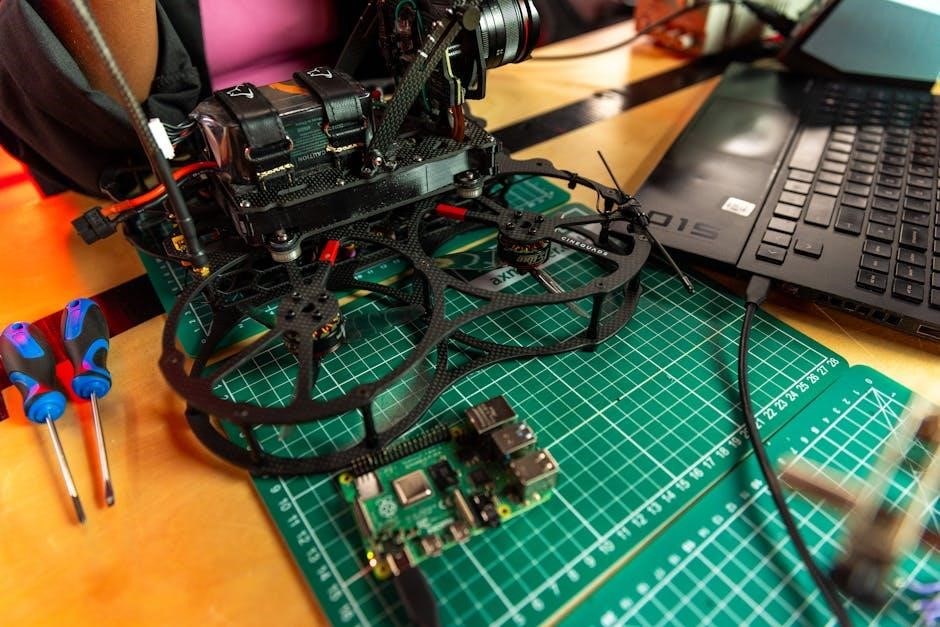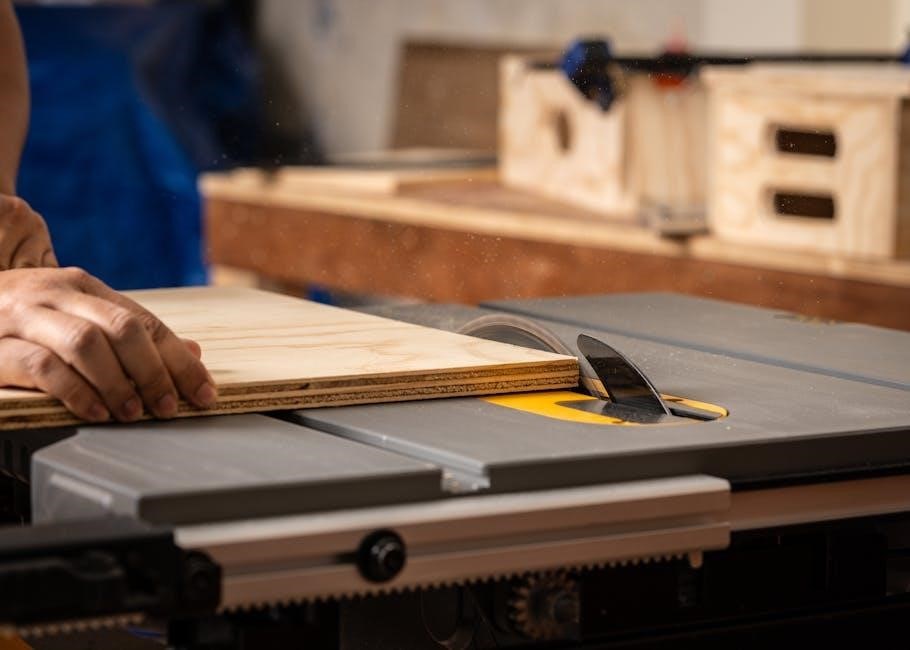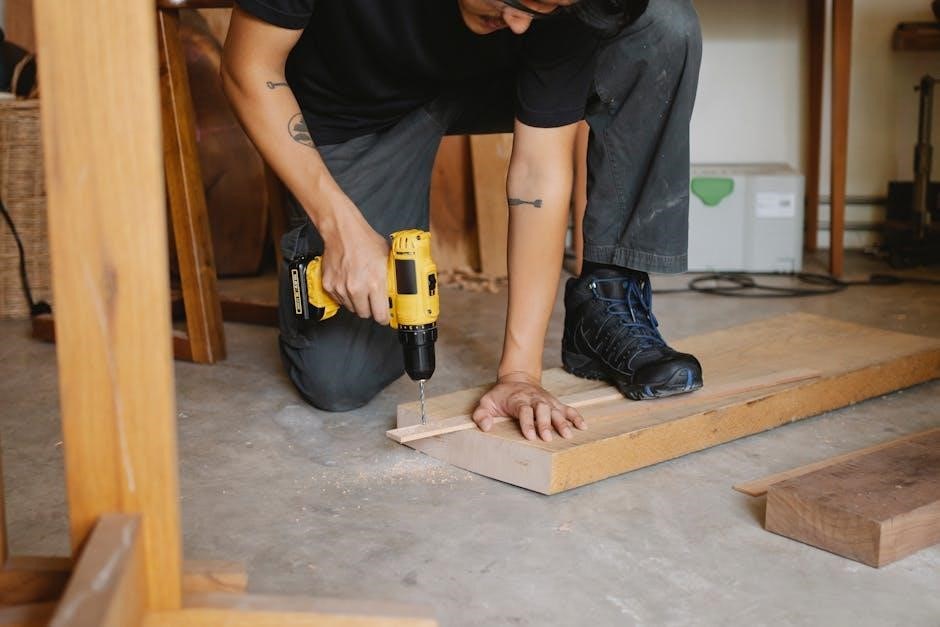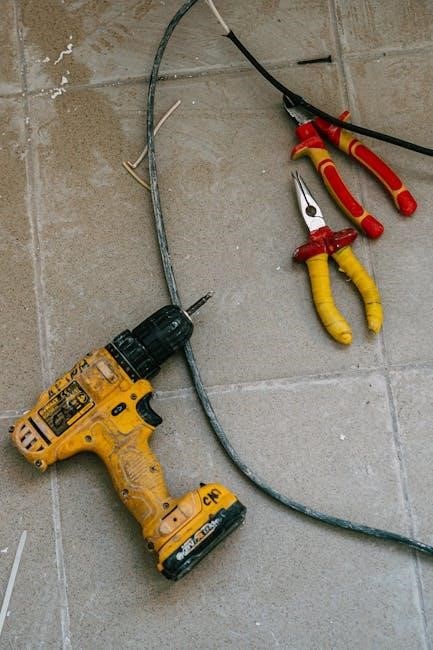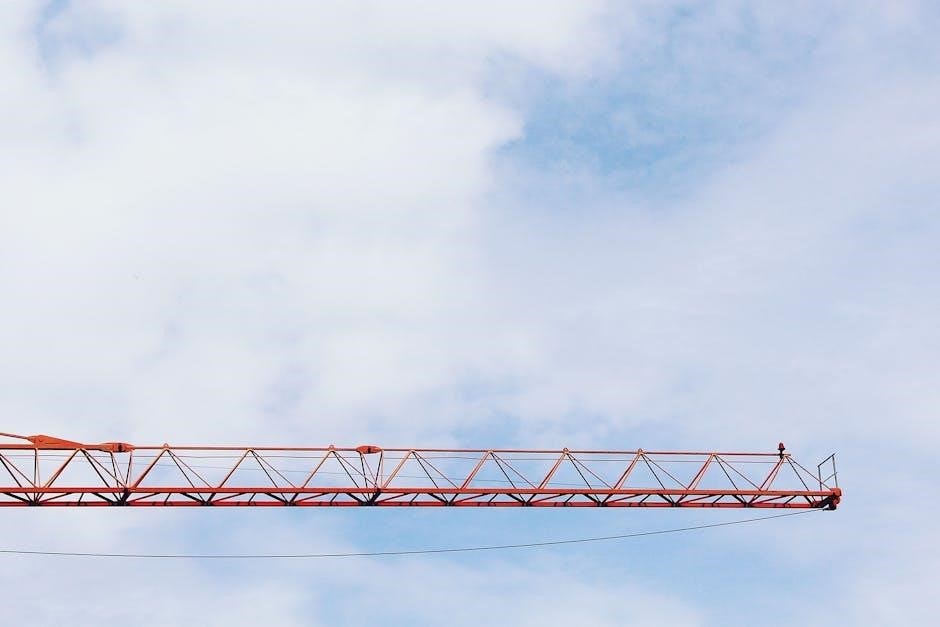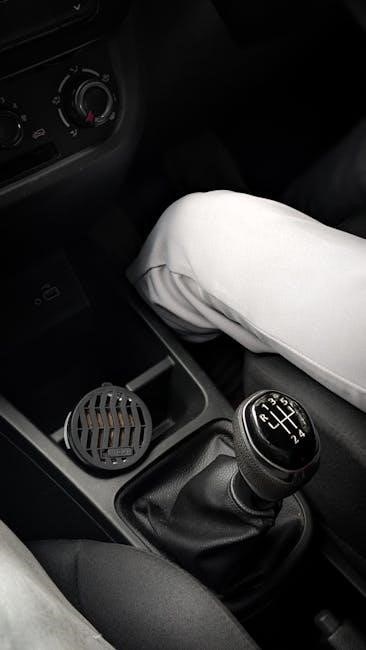manual dyson dc24
Welcome to the Dyson DC24 manual‚ your comprehensive guide to understanding and operating the Dyson DC24 upright vacuum cleaner․ This manual provides detailed instructions for optimal performance‚ maintenance‚ and troubleshooting‚ ensuring you get the most out of your appliance․ Available as a free PDF download‚ it offers clear‚ step-by-step guidance for users of all skill levels․
1․1 Overview of the Dyson DC24 Vacuum Cleaner
The Dyson DC24 is a compact‚ lightweight upright vacuum cleaner designed for efficient cleaning across various floor types․ It features Dyson’s signature digital motor technology‚ cyclonic suction‚ and a HEPA filtration system for capturing allergens․ The DC24 is ideal for multi-floor homes‚ offering easy maneuverability and adjustable settings․ Included accessories enhance versatility‚ making it a practical choice for everyday cleaning needs․
1․2 Importance of Reading the Manual
Reading the Dyson DC24 manual is essential for safe and effective use․ It provides key information on operation‚ maintenance‚ and troubleshooting․ Understanding safety guidelines‚ unlocking features‚ and ensuring proper care are vital․ The manual helps prevent damage and voiding the warranty‚ ensuring optimal performance and longevity of your Dyson DC24 vacuum cleaner․
1․3 Key Features of the Dyson DC24
The Dyson DC24 is a lightweight‚ upright vacuum with the Dyson Ball technology for easy maneuverability․ It features a powerful digital motor‚ advanced filtration‚ and multiple cleaning modes․ The vacuum includes a range of accessories for versatile cleaning․ Its compact design and energy-efficient performance make it ideal for various floor types‚ ensuring a thorough and efficient cleaning experience․

Safety Precautions
Always follow safety guidelines to ensure safe operation․ Avoid using damaged cords or plugging near water․ Keep children supervised and never leave the vacuum unattended while in use․
2․1 General Safety Guidelines
To ensure safe operation‚ always read and follow the instructions carefully․ Avoid using the vacuum near water or with damaged cords․ Keep children supervised and avoid blocking doors with the cord․ Regularly inspect the appliance for damage and ensure proper ventilation․ Consult flooring manufacturers’ guidelines before use to prevent damage․ Never leave the vacuum unattended while in operation․
2․2 Electrical Safety Tips
Always ensure the vacuum is used with a properly functioning electrical outlet․ Avoid using damaged cords or plugs‚ as they can pose a fire hazard․ Never submerge the appliance in water or expose it to excessive moisture․ Keep the cord away from hot surfaces and avoid overloading electrical outlets․ For your safety‚ do not attempt to modify or repair the electrical components yourself․ Consult a professional if issues arise․
2․3 Usage Restrictions and Warnings
Never use the Dyson DC24 near water or in damp environments‚ as this can lead to electrical hazards․ Avoid vacuuming hot coals‚ flammable materials‚ or sharp objects‚ as they may damage the machine or pose a safety risk․ Do not use the vacuum for commercial purposes or beyond its intended capacity․ Always ensure the vacuum is turned off and unplugged before performing any maintenance or cleaning․ Keep children away from the appliance while it is in operation․
Assembly and Initial Setup
Unpack and inventory all parts carefully․ Ensure all components are included and undamaged․ Follow the step-by-step assembly instructions provided in the manual for proper setup․
3․1 Unpacking and Inventory of Parts
Begin by carefully unpacking the Dyson DC24 vacuum cleaner․ Ensure all components‚ including the wand‚ hose‚ cleaner head‚ and accessories‚ are present and undamaged․ Refer to the parts diagram in the manual to verify each item․ This step ensures you have everything needed for proper assembly and operation‚ preventing any issues during setup․
3․2 Step-by-Step Assembly Instructions
Attach the wand to the vacuum’s main body by aligning the connectors and securing with a click․ Next‚ connect the hose to the wand‚ ensuring a tight fit․ Finally‚ snap the cleaner head into place at the base‚ making sure it rotates freely․ Double-check all connections for proper alignment and secure locking to ensure optimal performance․
3․3 First-Time Usage Checklist
- Unpack all components and verify the inventory against the manual․
- Complete the assembly as per the step-by-step guide․
- Check for any visible damage or missing parts․
- Plug in the vacuum and test the power button․
- Start with a low suction setting to familiarize yourself with its operation․
- Ensure all attachments are securely locked in place․
- Refer to the manual for additional setup instructions․
Operating Instructions
This section covers essential steps for operating the Dyson DC24‚ including turning it on/off‚ adjusting suction power‚ using cleaning modes‚ and maneuvering on different surfaces effectively․
4․1 Turning the Vacuum On and Off
To turn on the Dyson DC24‚ press the power button located on the handle․ Ensure the vacuum is on a hard‚ flat surface for stable operation․ To turn it off‚ press the power button again․ Always unplug the vacuum when not in use or before performing maintenance․ This ensures safety and prevents accidental start-ups․
4․2 Adjusting Suction Power
The Dyson DC24 features a variable suction control located on the handle‚ allowing you to adjust cleaning power based on surface type․ For delicate surfaces‚ reduce suction by moving the slider down․ Increase suction for deeper cleaning on carpets or stubborn dirt․ Ensure the filter is clean and free of blockages to maintain optimal suction performance across all settings․
4․3 Using Different Cleaning Modes
The Dyson DC24 offers multiple cleaning modes to suit various surfaces․ For carpets‚ use the Carpet mode by adjusting the cleaner head to the lowest setting․ For hard floors‚ switch to Hard Floor mode for gentle cleaning․ Some models also feature a Wand mode for above-floor cleaning․ Always ensure the vacuum is set to the correct mode for your surface to optimize cleaning efficiency and protect your floors․
4․4 Maneuvering the Vacuum on Various Surfaces
Maneuver the Dyson DC24 effortlessly across carpets‚ hard floors‚ and upholstery․ Adjust the cleaner head height for optimal contact on carpets and lower for hard floors․ Move smoothly in straight lines or gentle curves‚ avoiding sudden jerks․ For tight spaces‚ use the wand attachment․ Always ensure the vacuum is empty and filters are clean for consistent performance across all surfaces․

Maintenance and Care
Regular maintenance ensures optimal performance․ Clean filters monthly‚ check for blockages‚ and store the vacuum upright in a dry place․ Refer to the manual for detailed instructions․
5․1 Cleaning the Filter
Cleaning the filter is essential for maintaining suction power․ Use cold water to rinse the filter thoroughly‚ ensuring no debris remains․ Allow it to air dry completely before reinstalling to prevent mold or odors․ Regular cleaning every month ensures optimal performance and prolongs the life of your Dyson DC24 vacuum․
5․2 Checking for Blockages
Regularly inspect the wand‚ hose‚ and cleaner head for blockages․ Turn off and unplug the vacuum before checking․ Remove any visible debris or obstructions to ensure proper airflow․ If a blockage persists‚ refer to the manual or contact Dyson support for assistance․ Maintaining clear pathways is crucial for optimal performance and longevity of your Dyson DC24 vacuum cleaner․
5․3 Replacing Parts and Accessories
To replace parts or accessories on your Dyson DC24‚ ensure you use genuine Dyson components for optimal performance and warranty validity․ Refer to the manual for specific instructions or diagrams․ Contact Dyson customer support or visit an authorized service center for assistance․ Regularly replacing filters and worn parts will maintain your vacuum’s efficiency and extend its lifespan․ Always follow proper procedures to avoid damage during replacement․
5․4 Storing the Vacuum Properly
To store your Dyson DC24 vacuum correctly‚ ensure it is clean and dry․ Avoid exposing it to extreme temperatures or moisture․ Store the vacuum in an upright position to prevent damage to the motor or suction path․ If storing for an extended period‚ disconnect the battery (if applicable) and keep it in a cool‚ dry place․ Use a protective cover to prevent dust accumulation․
Troubleshooting Common Issues
This section helps identify and resolve common problems with your Dyson DC24‚ such as loss of suction‚ motor issues‚ or strange noises‚ ensuring optimal performance․
6․1 Loss of Suction Power
If your Dyson DC24 experiences reduced suction‚ check for blockages in the wand‚ hose‚ or inlet․ Ensure the filter is clean or replaced as needed․ Regularly emptying the dustbin and checking for clogs can restore performance․ Refer to the maintenance section for detailed filter care instructions to optimize your vacuum’s efficiency and maintain its cleaning effectiveness over time․
6․2 Motor Malfunction or Overheating
If the motor stops or overheats‚ turn off the vacuum immediately․ Check for blockages in the wand‚ hose‚ or inlet‚ and ensure the filter is clean․ Empty the dustbin and verify all components are securely connected․ Avoid using damaged or non-genuine Dyson parts․ If issues persist‚ contact Dyson customer support for assistance or refer to the troubleshooting section for further guidance․
6․3 Issues with the Wand or Hose
If the wand or hose is damaged‚ blocked‚ or not functioning properly‚ check for kinks‚ twists‚ or obstructions․ Ensure all connections are secure and clean․ Avoid using non-genuine Dyson parts‚ as they may cause compatibility issues․ If problems persist‚ contact Dyson customer support for assistance or refer to the troubleshooting guide for further solutions․
6․4 Strange Noises or Vibrations
If your Dyson DC24 produces unusual noises or vibrations‚ inspect the brush bar for blockages and ensure the filter is clean․ Check for loose parts or debris inside the vacuum․ If the issue persists‚ refer to the troubleshooting section or contact Dyson support for professional assistance to maintain optimal performance and extend the lifespan of your appliance․

Accessories and Additional Features
The Dyson DC24 includes crevice tools‚ combination nozzles‚ and other optional accessories for enhanced cleaning․ It also features innovative Ball Technology for easy maneuverability and a washable filter․
7․1 Included Accessories
The Dyson DC24 comes with essential accessories to enhance your cleaning experience․ These include a crevice tool for tight spaces‚ a combination nozzle for versatile cleaning‚ and a washable filter․ Additional tools like the stair tool and upholstery brush may also be included‚ depending on the model․ These accessories ensure comprehensive cleaning across various surfaces‚ from carpets to hard floors and upholstery․
7․2 Optional Accessories for Enhanced Cleaning
Optional accessories for the Dyson DC24 include a motorized brush for pet hair‚ an extension hose for extended reach‚ and a mattress cleaner for deep upholstery cleaning․ These tools enhance versatility‚ allowing for more effective cleaning of specific areas like stairs‚ upholstery‚ and tight spaces․ They can be purchased separately to customize your cleaning experience and tackle various cleaning challenges efficiently․
7․3 Special Features of the Dyson DC24
The Dyson DC24 features innovative technology‚ including the Dyson Ball design for effortless maneuverability and a powerful digital motor for strong suction․ It also includes a washable pre-filter and a HEPA filter for improved air quality․ The slim design allows for easy storage and navigation around furniture․ These features combine to provide an efficient and versatile cleaning experience‚ making it ideal for various home environments․
Technical Specifications
The Dyson DC24 weighs approximately 11․6 lbs and features a powerful digital motor with 160 AW suction power․ It includes a HEPA filtration system for allergen trapping and is designed for energy efficiency‚ making it a robust yet eco-friendly cleaning solution․
8․1 Dimensions and Weight
The Dyson DC24 measures approximately 43 inches in height‚ 11 inches in width‚ and 12 inches in depth‚ weighing around 11․6 lbs․ Its compact design and lightweight construction make it easy to maneuver and store‚ ensuring efficient cleaning without strain․ These dimensions are ideal for navigating tight spaces and handling various cleaning tasks with ease․
8․2 Suction Power and Motor Details
The Dyson DC24 is equipped with a powerful digital motor‚ delivering efficient suction while minimizing noise․ With a maximum suction power of 105 Air Watts‚ it ensures robust cleaning performance across various surfaces․ The motor’s design optimizes energy consumption‚ providing consistent airflow for effective dust and dirt removal․ This balance of power and efficiency makes it suitable for both hard floors and carpets‚ enhancing overall cleaning efficiency and user satisfaction․
8․3 Filtration System Overview
The Dyson DC24 features a washable filtration system designed to capture dust‚ dirt‚ and allergens effectively․ The filter is easily removable and washable‚ ensuring optimal performance and reducing maintenance costs․ Regular cleaning of the filter is recommended to maintain suction power and air quality․ This system contributes to a cleaner environment by trapping microscopic particles‚ making it ideal for allergy sufferers and pet owners alike․
8․4 Warranty and Service Information
The Dyson DC24 is backed by a comprehensive warranty program‚ offering coverage for parts and labor․ Registration is required to activate the 5-year guarantee‚ ensuring protection against defects in materials and workmanship․ For repairs or servicing‚ contact Dyson’s customer support or visit an authorized service center․ This ensures your appliance receives genuine parts and expert care‚ maintaining its performance and longevity effectively․
Environmental Considerations
Dyson DC24 is designed with eco-friendly features‚ promoting energy efficiency and sustainable use․ Proper recycling and disposal guidelines are provided to minimize environmental impact and ensure responsible ownership․
9․1 Energy Efficiency
The Dyson DC24 is engineered to deliver efficient cleaning with minimal energy consumption․ Its advanced motor and optimized design ensure powerful suction while maintaining low power usage‚ contributing to a greener environment․ Eco-friendly features like automatic shut-off and energy-saving modes help reduce electricity consumption‚ making it an environmentally responsible choice for everyday cleaning tasks and long-term sustainability․
9․2 Recycling and Disposal Guidelines
Proper recycling and disposal of your Dyson DC24 are crucial for environmental sustainability․ Check local regulations for electronic waste disposal and recycle components like batteries and plastics․ If upgrading‚ consider donating a working unit to charity or recycling it through authorized programs․ Always disconnect the battery and dispose of it safely․ Responsible disposal helps reduce waste and supports eco-friendly practices․
9․3 Eco-Friendly Design Features
The Dyson DC24 is designed with eco-friendly principles in mind․ It features an energy-efficient motor and lightweight construction to reduce environmental impact․ The vacuum uses recyclable materials and is built to last‚ minimizing waste․ Additionally‚ the washable filter reduces the need for replacements‚ contributing to a more sustainable cleaning experience․ Dyson’s commitment to eco-friendly design ensures a greener approach to home cleaning․
Downloading the Dyson DC24 Manual
Download the Dyson DC24 manual as a free PDF from Dyson’s official website or authorized sources․ Ensure you access the manual from trusted platforms for safety and accuracy․
10․1 Finding the Official PDF Manual Online
To find the official Dyson DC24 manual‚ visit Dyson’s website and navigate to the support section․ Enter your product model‚ and download the PDF manual directly․ Ensure you use trusted sources to avoid unauthorized versions․ This official guide provides essential information for proper usage‚ maintenance‚ and troubleshooting‚ ensuring optimal performance of your Dyson DC24 vacuum cleaner․
10․2 Printing the Manual for Easy Reference
For convenience‚ print the Dyson DC24 manual using a high-quality printer; Ensure the PDF is downloaded from Dyson’s official website to avoid formatting issues․ Use durable paper and consider binding for long-term use․ Printing the manual allows easy access to instructions during assembly‚ maintenance‚ or troubleshooting‚ ensuring you can refer to it without needing a digital device nearby․
Repair and Servicing Options
Authorized Dyson service centers offer repairs‚ including labor and parts‚ with a 12-month guarantee․ Contact Dyson Customer Support for assistance or to locate a nearby service center․
11․1 Authorized Service Centers
For reliable repairs‚ visit Dyson’s authorized service centers․ These centers provide expert maintenance‚ genuine parts‚ and guaranteed service․ The repairs include labor and spare parts‚ excluding additional accessories and filters‚ with a 12-month warranty․ Ensure your Dyson DC24 is serviced by professionals to maintain its performance and longevity․ Visit Dyson’s website or contact customer support to locate a nearby center․
11․2 DIY Repair Tips (Where Applicable)
While Dyson recommends professional servicing‚ certain minor repairs can be done at home․ Regularly cleaning filters and checking for blockages can prevent suction loss․ Ensure to use only Dyson-approved parts to maintain warranty and performance․ For complex issues‚ always refer to the user manual or contact Dyson support․ Simple maintenance tasks can enhance your vacuum’s efficiency and extend its lifespan․
11․3 Contacting Dyson Customer Support
For any inquiries or assistance‚ contact Dyson’s Customer Support team via phone‚ online chat‚ or email․ They are available to help with repairs‚ troubleshooting‚ and maintenance advice․ Additionally‚ the Dyson website offers downloadable resources and FAQs․ Ensure to have your product serial number ready for efficient service․ Dyson also provides a 5-year guarantee on parts and labor for registered devices‚ excluding filters and accessories․
12․1 Summary of Key Points
This manual provides a comprehensive guide for the Dyson DC24‚ covering assembly‚ operation‚ maintenance‚ and troubleshooting․ It emphasizes safety precautions‚ proper usage‚ and regular upkeep to ensure longevity․ The DC24’s features‚ such as adjustable suction and various cleaning modes‚ are highlighted to maximize efficiency․ By following the manual’s instructions‚ users can optimize performance and maintain their vacuum effectively over time․
12․2 Final Tips for Optimal Performance
Regularly clean or replace filters to maintain suction power․ Check for blockages in the wand or hose to ensure smooth operation․ Empty the dustbin after each use and store the vacuum in a dry‚ cool place․ Use only genuine Dyson parts for repairs or replacements․ Always follow the manual’s guidelines for different floor types and cleaning modes to prolong the life of your Dyson DC24․

















